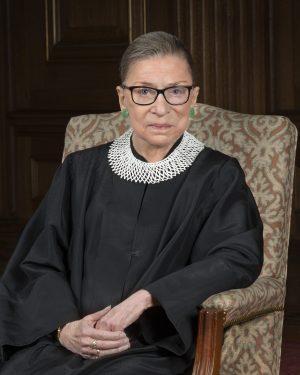THE NATION MOURNS FOR RUTH BADER GINSBURG

On Sept. 19, Ruth Bader Ginsburg, 87, noted Associate Justice of the U.S. Supreme Court, died after battling pancreatic cancer.
She was the second woman to have been successfully nominated for the Supreme Court, following Sandra Day O’Connor, and was the first Jewish female Supreme Court justice. Ginsburg was nominated by President Bill Clinton in 1993, serving a total of 27 years on the nation’s highest court.
This week, Americans have mourned Ginsburg, coast-to-coast. Rising all the way to one of the highest positions in the country, fighting barriers of discrimination along her path, she remained humble in remembering that the fight for equality is ever-permanent. She explicitly said that her favorite amendment within the Constitution is the 14th Amendment, citing the words, “… and nor shall any state deny to any persons the equal protection of the laws.”
Few have earned the widespread respect and love of the people more than Ginsburg, who made friendships with her judicial opposite, Justice Antonin Scalia, and even drew President Trump to personally pay his respects outside the Supreme Court this week. And even fewer prominent officials have embodied the same idea of equality as Ginsburg.
A look back at her remarkable life surely helps explain how, and why, this is true. Born Joan Ruth Bader in 1933 to a furrier and a garment factory worker, Ginsburg grew up to be the only surviving child of Nathan and Celia Bader, after her elder sister Marilyn died at age 6 (when Ginsburg was 18 months old).
She described her mother as an excellent student in her youth who was forced to drop out of school to assist in covering her brother’s college expenses. Celia Bader instilled a strong sense of value in education in her, due to having missed out on finishing school.
Ginsburg said the source of her motivation for women’s rights was ignited when her mother died, the day before her own high school graduation.
She would go on to Cornell University where she would meet her husband, Martin Ginsburg, in her first year there. She often described her husband as being “the only young man I dated who cared that I had a brain.”
Shortly after graduating at the top of her class, Ginsburg married Martin and started a family. Then, he was drafted into the military for two years while she raised her first child, Jane, as a single mother.
When Martin came back from military service, Ginsburg enrolled at Harvard Law School, where she was one of nine females out of 500 students and would become the first female to join the prestigious Harvard Law Review. She recalls a story about her experience with sexism at Harvard in the documentary series “RBG,” where the dean of Harvard Law invited all the female students to his home for dinner and made sexist remarks. “He asked all of us to stand up and tell him ‘What we were doing, taking a seat that could be occupied by another man?’ ” she remembered.
Ironically, the dean’s position would eventually be filled by Harvard law professor Albert Martin Sacks, who strongly advocated for Ginsburg’s employment, and the position’s first female (dean of Harvard Law) would be Elena Kagan in 2003, who would become the fourth female justice in the Supreme Court.
In Ginsburg’s last year of law studies, she decided to enroll in Columbia Law School when her husband took a job in New York City. She graduated Columbia Law School tied for first in her class and just as she broke the gender barrier at the Harvard Law Review, was its first woman graduate.
Justice Ginsburg is widely recognized as being a fierce advocate for women’s rights, both prior to and while serving on the bench. A few of those cases where she had battled for women’s rights on the bench include a majority opinion on United States v. Virginia (1996), which addressed a controversial male-only admission policy at the Virginia Military Institute. She argued that female exclusion at the military college was a violation of the 14th Amendment.
Ginsburg also provided a dissenting opinion on Ledbetter v. Goodyear Tire & Rubber Co. (2007), which revolved around gender pay discrimination. Upon the conclusion of the case, she said that the Court’s ruling was not an accurate reflection of how wage discrimination is performed in practice.
Next was a case which resulted in a majority opinion on Obergefell v. Hodges (2015), which questioned if states must license a marriage between a same-sex couple and if states must recognize a same-sex marriage performed in another state. Ginsburg was noted to have been particularly outspoken, famously challenging the argument that the purpose of marriage was to sire children and contending that same-sex marriage does not intrude in any way on the right of another person’s marriage.
Ginsburg was a noted follower of loose constructionism, or as being a “a living constitutionalist.” As a living constitutionalist, she advocated that the definitions and meanings within the U.S. Constitution are dynamic and ever-evolving to new situations.
She was interviewed in 2008 on the news show “60 Minutes,” where she was asked about her perspective on being a living constitutionalist. She replied that her views were similar to those of Thurgood Marshall (first Black Justice in the Supreme Court) and quoted him saying, “I celebrate not the Constitution that was published in 1787, but what the Constitution has become.”
She added that after the Constitution was published, definitions have changed over time without the court’s permission, such as the “we the people” proclamation – noting that the original definition did not include women, African-Americans, or Native Americans but has evolved into including those groups.
Ginsburg summarized her view on the Constitution with the statement, “I see the Constitution as striving for a more perfect union.”
Given the nation’s current period of bitter political conflict, we join others in hoping that this determined, dedicated woman may rest in peace.

Leave a comment